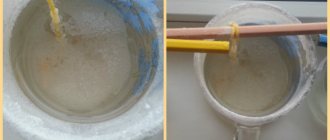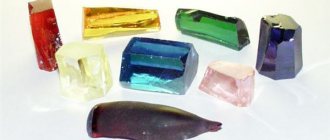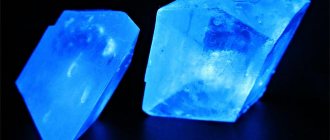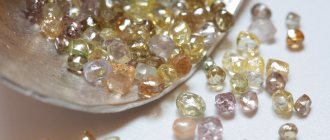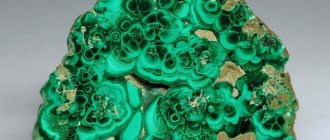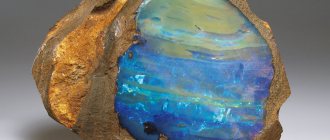CRYSTALS (from the Greek ϰρύσταλλος - ice; rock crystal), solid or liquid substances consisting of regularly arranged atoms, molecules, ions or their groups. The size of the latter can be 10–10,000 nm or more. In solids, these particles are arranged in identical parallelepipeds, the so-called. elementary cells. A cell can be represented as an nesting of several Bravais lattices, in each of which the nodes are occupied by atoms of the same type. The number of embeddings is determined by the number of types of atoms in nonequivalent positions in the crystal. Periodic The repetition in space of a unit cell constitutes a crystal structure, and all nested Bravais lattices constitute a crystal lattice. Liquid crystals are composed of parallel oriented organics. molecules elongated in a ratio greater than ca. 1:2.5. In the so-called smectic liquid K. these layers are approximately parallel to each other.
Crystal symmetry
Rice. 1. Image of the structure of a SrTiO3 crystal with an edge dislocation D along the [100] direction in an electron microscope; the white line is an incomplete molecular plane ending in a dislocation...
The need for continuous regular filling of space allows for the possibility of symmetry axes of only the 2nd, 3rd, 4th, and 6th orders in a frame, that is, the combination of a frame (all its parts) with itself when rotating around an axis by 180°, 120°, 90° and 60°. Crystals may have other symmetry operations—planes of symmetry and a center of symmetry (see Symmetry of crystals). The set of all symmetry operations that leave one point fixed forms a point symmetry group of a complex. The group of atoms, the periodic repetition of which any structure of a complex is built, belongs to one of 32 classes of point symmetry, and the entire structure belongs to one of 230 groups of spatial symmetry. 32 classes of point symmetry are distributed over 7 systems (systems). In order of decreasing symmetry, these are: cubic, hexagonal, trigonal, tetragonal, orthorhombic, monoclinic and triclinic systems. In this order, the number of arbitrary angles and unequal lengths of the sides of the unit cell increases. The symmetry of K. imposes restrictions on its possible properties. Thus, crystals with a center of symmetry cannot spontaneously have oppositely charged faces, that is, they cannot be pyroelectrics or ferroelectrics.
The structure and symmetry of a crystal follow from the nature of the interaction between its particles. In carbon, this is electromagnetic interaction, which is determined primarily by electrons. Chemical type The bonds between atoms in crystals determine many of their properties (see Ionic crystals, Covalent crystals, Metallic crystals, Molecular crystals).
K. of this chemical. composition and structure exist only in certain temperature and pressure ranges. For example, ice at atmospheric pressure is stable only below 0 °C, iron - below 1538 °C. Outside these intervals, particles either melt, or evaporate, or, while remaining solid, change the arrangement of particles, i.e., the structure, passing into another, the so-called. polymorphic modification (see Phase transition). Splices K. decomp. orientations and powders are called polycrystals.
K.'s structure is usually determined by X-ray structural analysis. A complex can be represented as a set of mutually parallel and variously oriented families of planes along which the atoms of the crystal are located. The surface density of atoms in each family is different. The X-ray beam is reflected most intensely from the X-ray planes with the highest atomic density. By recording the intensity of reflections from different angles, not only the structure of the crystal is deciphered, but also the structure of its constituent molecules. The larger the size of the unit cell and the more perfect the crystal, the more measurable reflections can be obtained and the more accurately the coordinates of atoms can be determined. Structures of hundreds of thousands of inorganic connections are collected in international. data banks. Growing more than 20 thousand cells from protein molecules and viruses made it possible to determine the structure of these biological ones. molecules and particles, sometimes containing tens of thousands of atoms (see Biological crystal). Modern electron, atomic force and tunneling microscopy make it possible to see the atomic structure of carbon (Fig. 1).
Growing a crystal from salt
You can also grow crystals from salt at home. To do this you will need salt, a glass container, thread, pencil, water. So, how to grow a salt crystal?
- Pour salt into a glass of water in portions and mix thoroughly until it is completely dissolved.
- The liquid is put on fire and heated to 90°C. The water is brought to a boil, but not boiled. The solution is cooled and filtered - there should be no sediment in it.
- Then the thread is tied to a pencil, and to it is a salt crystal or a button, which must first be dipped in a saline solution and dried.
- The tip of the thread with the attached bait is lowered into a container with dissolved salt so that it does not touch the bottom and walls.
- Cover the container with a clean napkin and place in a warm place. The temperature must be constant.
The time it takes for a crystal to grow varies. It depends on its desired size.
Crystals in nature
Most substances on Earth and other planets are in solid crystalline form. condition. In nature, minerals are called minerals. They make up the miner. raw materials, e.g. metal salts and oxides (ores), quartz (SiO2), calcite (CaCO3, in fine crystalline form - marble), granite. K., which are part of living organisms, are biominerals, they are predominant. are poorly soluble metal salts (Ca, Mg, Mn, etc.) of carbonic or phosphoric acids, alternating with the deposition of proteins. Bones and teeth are 70% composed of K. hydroxyapatite, the unit cell of which contains two molecules of Ca5(PO4)3OH. The size of K. biominerals ranges from several nm to several microns. Stones in the kidneys and pancreas can reach several mm and cm. Polymers consist of parallel layers in which long chains of polymer molecules are laid.
Colloidal particles with a size of 102–103 nm, equally charged with liquid ions adsorbed on them, are ordered in this liquid into colloidal particles, since dense packing in a cell allows more particles to be placed per unit volume than with a chaotic arrangement.
Natural opals are close-packed balls of amorphous SiO2 with a diameter close to the wavelength of visible light (approx. 0.5 μm), “glued together” with a filler in the interparticle space (see Photonic crystal).
Snowflake
One of the most interesting and unusual crystals are snowflakes. Snowflakes are ice crystals in the form of needles, prisms, hexagons, plates, etc.
Shape of snowflakes at different temperatures
When water molecules crystallize, they can only form three or hexagonal shapes. This is the main reason for the hexagonal shape of snowflakes!
What determines the shape of snowflakes?
The shape of snowflakes depends on several factors:
- the temperature at which a snowflake is formed,
- altitude above sea level,
- the content of water vapor in the cloud in which this snowflake formed.
Snowflakes fall very slowly: their speed is approximately 1 km/h. During the fall, they have to “experience” different temperatures, so the shape of the snowflakes is constantly changing.
Crystal Shape
Rice. 2. Initial stage of formation of dendritic succinonitrile single crystal. Photo by M. E. Gliksman (Florida State University).
The form of unprocessed K. is the form of its growth (see Crystallization); it reflects the atomic structure of crystals. The planes of crystals, in which the density of atoms is greatest, grow most slowly, through the successive generation and propagation of new layers one or several thick. elementary cells. Therefore, they are usually limited to crystalline ones. polyhedra growing from vapors, solutions or chemically complex melts. For substances with low entropy of fusion, e.g. in metals, thermal motion disorderes surfaces of any orientation. Then K. grows at almost the same speed in all directions and is almost spherical. form. This form is unstable and turns into the so-called. dendritic (Fig. 2). Metallurgical an ingot is a conglomerate of fused intertwined dendrites. Snowflakes are dendrites of ice grown from vapor. Despite its bizarre shape, the dendrite has a single crystalline structure. lattice, i.e. it is a single crystal.
Rice. 3. Some simple forms of crystals (a); combination of simple forms (b); observed crystal cuts (c).
A set of crystallographically identical faces, i.e., faces that are combined with each other during symmetry operations of a given class of point symmetry, forms the so-called. simple form K. There are 47 simple forms in total, but only some of them can be implemented in each class. A stone can be faceted by edges of one simple shape (Fig. 3, a), but more often by edges resulting from a combination of these shapes (Fig. 3, b, c). A crystal belonging to a class containing only rotational axes of symmetry (not containing planes, centers of symmetry or inversion axes), e.g. quartz can crystallize into mirror-like decomposition. forms - right and left (so-called enantiomorphism).
Geode - a miracle of nature
Nature has created many amazing creations, and one of them is geodes. Geodes are unusual, hollow rocks that are completely or partially filled with overgrown crystals. Geodes come in all shapes, but the most common are round or oval.
From the outside, geodes are nothing remarkable: they look like ordinary stones. All their beauty becomes obvious only after sawing. Sometimes geodes are called “boxes with a surprise”: after all, it is really unknown what beauty is hidden in them.
Amethyst Geodes
Geode sizes vary from 1 cm to 1 m, the smallest specimens (less than 1 cm) are called tonsils. The crystals formed in geodes depend on the mineral matter that originally entered the underground voids. The most common geodes are quartz, amethyst, rock crystal, agate, and chalcedony.
Properties of crystals
depend on the direction in K., i.e. the crystal is anisotropic. For example, the same potential difference applied in different directions in a single crystal causes differences. electric current. Dependence of the direction and strength of the current on the applied electric current. fields are described by a conductivity tensor of the 2nd rank, and not by a single number, as in the case of the conductivity of an amorphous solid or liquid. The number of independent and non-zero components of the tensor is determined by the point symmetry of K. Similarly, the external electric. field, differently oriented relative to the crystalline. dielectric lattice, causes dif. ion displacement (polarization) that is not parallel to the applied field. Therefore, the speed of light in non-cubic space, for example. KH2PO4 (KDP), depends on the direction in K., and the light beam bifurcates. Both beams can run parallel in selected directions (synchronism), and then electric. the fields of their light waves add up. Tensor dielectric permeability of the 2nd rank K. depends on the field through the tensor of the 3rd rank electro-optical. coefficient As a result, a second harmonic occurs, i.e., the frequency of the light passing through the KDP doubles. This is used in optics, in particular in the laser systems being created to produce energy through the fusion of deuterium and tritium nuclei. Electro-optical the effect is also used to deflect a ray of light passing through a K. by applying a potential difference to the K. Tensor of the 3rd rank piezoelectric. coefficient determines the potential difference between the faces of the circuit, i.e., the electrical vector. K. polarization caused by mechanical load on the K. (stress tensor in K.). The effect is used to measure small voltages and displacements. The opposite effect, the deformation of the surface under the action of an applied field (see Electrostriction), controls the movement of the surface probe needle in scanning tunneling and atomic force microscopes.
Spatial crystal lattice
If instead of particles - ions and atoms - we put dots, then the structure of the crystal is a space that is filled with dots arranged in a regular order. If you connect them with lines, you get a spatial lattice consisting of the following elements:
- nodes, which are the locations of crystal particles;
- rows represented by a set of nodes that are periodically repeated at equal distances (the nodes lie along straight lines);
- gaps, which is the distance from one to another equivalent node (these gaps are negligible);
- a flat mesh, which consists of nodes and rows that are located in a single plane.
Crystal defects –
this is a violation of the strict periodicity of its structure. Point defects include empty nodes (vacancies), foreign particles in lattice nodes or interstices (impurities); linear defects – dislocations, which are the edges of unfinished lattice planes inside the crystal (Fig. 1); two-dimensional defects—the boundaries of kinetic regions rotated relative to each other, stacking faults, and boundaries of twins. In K. macroscopic. inclusions, as well as internal mechanical stresses caused by point, line and two-dimensional defects. Almost all defects significantly change the semiconductor properties of metals and reduce the electrical conductivity of metals; impurities and vacancies change the color of dielectrics, affect the ease of repolarization of ferroelectrics and magnetization reversal of ferromagnets, etc. Dislocations, grain boundaries, and stacking faults completely determine the plasticity and strength of crystals, but have little effect on their elasticity.
Rice. 4. KH2PO4 (KDP) crystal measuring 54x55x56 cm, grown at a rate of approx. 1.5 cm/day. Photo by N. P. Zaitseva, J. J. de Yoreo, L. N. Rashkovich (Livermore National Laboratory...
Rice. 5. CdSe nanosingle crystal, in which the wavelength of absorbed light (color) changes with the size of the crystal. Transmission electron microscopy, the crystal lattice is visible. Photo by N.P. Zaitseva (Li...
Growing crystals. Single crystals are most often grown from melts, less often from solutions and vapors (see Crystallization). The advantage of melts is the proximity of the densities of the melt and the melt, which allows you to achieve max. growth rate (on the order of several mm/min). On the contrary, thin monocrystalline. films for electronics receive Ch. arr. in gas-phase processes, mainly surface, chemical reactions, as well as the condensation of molecular beams in a vacuum at a speed of the order of several nm/min on plates cut from single crystals. In this case, the phenomenon of epitaxy is used - the oriented growth of one crystal on another. To the beginning 21st century The semiconductor crystal industry grows approx. 6 thousand tons of silicon per year. Single crystals of dislocation-free Si with a density of point defects on the order of 10–10 times the atomic density, with a diameter of up to 30 cm and a length of up to 2 m, are pulled from the melt. Similar methods are used when growing smaller laser cells. The growth rate of KDP from solution is much lower (on the order of several mm/day), but the efforts, including joint efforts, of scientists in Russia and the USA make it possible to industrially grow KDP KDP in size of approx. 0.5 m (Fig. 4) at a speed of approx. 1.5 cm/day while maintaining high perfection. The main interrelated problems of cultivation remain the perfection and purity of the crystals.
Polycrystalline metal ingots – Ch. metallurgy products. Controlling the size, shape and evolution of these compounds, studying the role of additives, their selection, and much more. other questions - the subject of metallurgy. Polycrystals in the form of powders are also widely produced by industry. Nanocrystals with a size of 1–100 nm (Fig. 5) are obtained chemically. reactions in solutions or gases. To avoid the enlargement of nanocrystals caused by a decrease in their total surface energy, they are covered with thin shells. It is also promising to grow long (on the order of several mm) nanotubes - rolled up layers of graphite, as well as whisker-like crystals.
Definition
A crystal is a body of solid consistency with a multifaceted shape. Its occurrence is the result of the arrangement of particles: atoms, molecules, ions in a certain order. Their task is to form rows, flat grids and spatial lattices.
Polyhedral crystals can be:
- in the form of cubes - pyrites;
- prisms with pointed ends - rock crystal;
- dodecahedrons - garnet;
- octahedrons – iron ore (magnetite);
- precious stones - diamonds, topazes, rubies and others.
The sizes of these formations can be quite large.
A crystal is a body, the top of which must correspond to an atom, ion, or molecule. An edge, respectively, is for each row of particles, and a face is for the mesh. If you enlarge real crystals many times, you can see that the top, edge and face consist of many particles, rows, and grids that are located in parallel.
Applications of crystals
K. is the basis of many modern ones. devices. They are the main functional elements of solid-state electronics: computers, generators and receivers of radiation (including laser), magnetic recording devices, consumer electronics, etc. They are widely used in optics, as well as as structural materials (for example, sapphire) in many varieties. sensors and other precision instruments. Crystallic. powders (salt, sugar, medicines, mineral fertilizers, explosives, etc.) are widely used in food, pharmaceutical. industry, agriculture, metallurgy and other areas.

